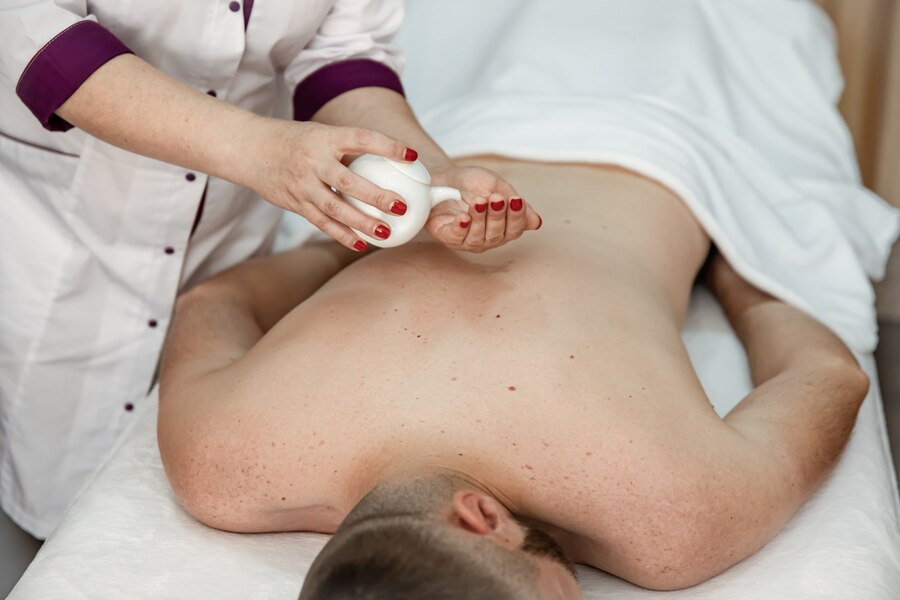Deep tissue massage is a therapeutic technique that targets the deeper layers of muscle tissue and fascia (the connective tissue surrounding muscles). It is widely known for its ability to alleviate chronic pain, reduce muscle tension, and promote overall relaxation. If you’re considering a deep tissue massage for pain relief or muscle recovery, this comprehensive guide will walk you through everything you need to know. From the techniques used to its numerous benefits and what to expect during a session, this guide will help you understand why deep tissue massage might be the right choice for you.
What Is Deep Tissue Massage?
As the name suggests, deep tissue massage involves applying firm pressure and slow strokes to reach the deeper layers of muscle and connective tissue. The primary goal of deep tissue massage is to break down muscle knots, relieve tension, and reduce chronic pain. This type of massage is often used for individuals dealing with muscle injuries, tension, or long-term stress, and it differs from other forms of massage in both the pressure and the areas targeted.
Unlike Swedish massage, which uses lighter strokes for relaxation, deep tissue massage focuses on deeper muscle layers and connective tissues. The massage therapist uses their fingers, elbows, forearms, and even knuckles to apply more pressure to specific areas that need attention.
How Does Deep Tissue Massage Work?
The primary focus of deep tissue massage is to reach the deeper layers of muscle and connective tissue. Here’s how the process typically works:
- Pressure and Techniques: The massage therapist will use slow, deliberate strokes and deep pressure to target areas of tightness and tension. They may use their fingers or forearms to apply direct pressure to muscle knots or areas with chronic pain.
- Breaking Down Tension: The therapist works to break down adhesions (knots) in the muscle tissue that can restrict blood flow and cause pain. By doing so, blood flow is improved, helping to bring oxygen and nutrients to the muscles, speeding up the healing process.
- Fascia Release: Fascia is the connective tissue that surrounds muscles, bones, and organs. Deep tissue massage can help release tightness in the fascia, improving muscle flexibility and range of motion.
Benefits of Deep Tissue Massage
Deep tissue massage offers numerous benefits, both physically and mentally. Here are some of the most notable advantages:
1. Relieves Chronic Pain
One of the main reasons people opt for deep tissue massage is its ability to relieve chronic pain. Whether you’re dealing with ongoing back pain, neck stiffness, or conditions like sciatica, deep tissue massage targets the underlying muscle tissues and helps break down knots that contribute to pain.
2. Reduces Muscle Tension and Stiffness
If you have tight, stiff muscles due to sitting at a desk for long periods or engaging in intense physical activity, deep tissue massage can be incredibly beneficial. It helps release muscle tension by targeting the deeper layers of muscle fibers that are harder to reach with other types of massage.
3. Improves Circulation
By applying firm pressure to specific areas of the body, deep tissue massage helps to improve circulation. The improved blood flow helps to bring oxygen and nutrients to the muscles while removing toxins and metabolic waste. This promotes healing and helps muscles recover more quickly from strain or injury.
4. Reduces Stress and Anxiety
Although deep tissue massage is known for targeting deeper muscle layers, it also promotes relaxation. By relieving muscle tension, deep tissue massage can trigger a reduction in stress hormones like cortisol, helping to create a sense of calm. Additionally, it can stimulate the production of feel-good hormones like serotonin and dopamine, which can help improve mood and reduce anxiety.
5. Helps with Injury Recovery
For athletes or individuals who have recently experienced an injury, deep tissue massage can aid in the recovery process. By improving circulation and breaking down muscle adhesions, deep tissue massage accelerates the healing of soft tissue injuries, such as sprains, strains, or muscle tears.
6. Improves Posture
Poor posture is often the result of muscle imbalances or tightness, particularly in the neck, back, and shoulders. Deep tissue massage can help release the tension in these muscles, making it easier to correct your posture and maintain better alignment throughout the day.
7. Enhances Flexibility and Range of Motion
The deep pressure applied during a deep tissue massage can help improve flexibility by loosening tight muscles and breaking down adhesions in the fascia. This, in turn, can improve your range of motion, making everyday movements feel easier and more fluid.
What to Expect During a Deep Tissue Massage
If it’s your first time getting a deep tissue massage, it’s important to know what to expect. Here’s an overview of the typical deep tissue massage experience:
1. Consultation
Before the massage begins, your therapist will ask you questions about your health history and any areas of tension or pain you’re experiencing. This will help them tailor the massage to your specific needs. If you have any injuries, medical conditions, or areas of concern, be sure to mention them.
2. The Massage Process
During the session, you will lie on a massage table, and the therapist will apply slow, firm strokes and pressure to target your muscles. While the pressure may feel intense at times, it should not be painful. It’s important to communicate with your therapist throughout the session if the pressure is too strong or not enough.
Deep tissue massage often focuses on problem areas, such as the lower back, shoulders, neck, and upper thighs. The therapist may use various techniques, such as kneading, friction, or deep strokes, to work out muscle knots and tension.
3. Post-Massage Effects
After the massage, you may feel some soreness in the areas that were treated. This is completely normal and should subside within 24 to 48 hours. It’s similar to the feeling you might experience after an intense workout. To help reduce any soreness, it’s recommended to drink plenty of water, as this will help flush out toxins and aid in muscle recovery.
You may also feel incredibly relaxed and even a little tired after the session. Some people experience an improvement in their range of motion and flexibility right away, while others may need a few sessions to feel the full benefits.
Deep Tissue Massage Techniques
Deep tissue massage utilizes several techniques to target deeper muscle layers. Here are some of the most common techniques:
1. Myofascial Release
Myofascial release is a technique used to release tension in the fascia, the connective tissue surrounding muscles. This technique involves applying gentle, sustained pressure to the fascia to stretch and release tightness.
2. Trigger Point Therapy
Trigger point therapy involves applying concentrated pressure to specific areas of muscle knots or “trigger points.” These points are often the source of referred pain, meaning the pain is felt in one area but originates in another. By targeting these points, the therapist can help reduce pain and tension.
3. Cross-Fiber Friction
This technique targets the deeper layers of muscle tissue by applying pressure across the muscle fibers (rather than along them). Cross-fiber friction helps to break down adhesions and scar tissue, which can form as a result of past injuries or muscle overuse.
4. Stretching
Stretching is often incorporated into deep tissue massage to increase flexibility and range of motion. The therapist may gently stretch muscles as part of the massage, helping to loosen tight areas and improve overall mobility.
When Should You Get a Deep Tissue Massage?
Deep tissue massage is ideal for individuals experiencing chronic pain, muscle stiffness, or those recovering from an injury. It is also beneficial for athletes who need to relieve muscle tension after intense workouts. If you lead a sedentary lifestyle and have poor posture, deep tissue massage can help improve flexibility and prevent discomfort.
However, deep tissue massage is not recommended for everyone. If you have certain medical conditions, such as osteoporosis, blood clotting disorders, or a recent injury, consult with a healthcare provider before getting a deep tissue massage.
Conclusion
Deep tissue massage is a highly effective form of therapy for alleviating chronic pain, reducing muscle tension, and improving overall well-being. By targeting the deeper layers of muscle and connective tissue, deep tissue massage helps release tension, improve circulation, and promote healing.
If you’re dealing with muscle stiffness, chronic pain, or recovering from an injury, deep tissue massage can provide significant relief. However, it’s important to communicate with your therapist to ensure the session is tailored to your needs and comfort levels. Whether you’re seeking pain relief or simply want to improve your flexibility, deep tissue massage is an excellent way to support your overall health and wellness.
Also Read
- ► Web Design El Paso: Building Strong Online Connections
- ► Jeddah to Makkah Taxi Fare Insights for Travelers
- ► Elevate Your Streetwear with the Spider Hoodie
- ► Essentials Clothing
- ► Learn Quran with Tajweed in Easy Online Courses
- ► Essentials Hoodies: The Key to Effortless, Minimalist Fashion
- ► Styling a Sp5der Hoodie: The Ultimate Guide
- ► Styling a Sp5der Hoodie: The Ultimate Guide
- ► Suicideboys Merch: The Perfect Blend of Music and Streetwear
- ► What is Lufthansa’s 24-Hour Rule? Everything You Need to Know
- ► Corteiz hoodie has quickly emerged as one of the most coveted
- ► Luxury Packaging Makes Products Shareable on Different Platforms
- ► Affordable Mold Remediation Solutions Near Your Home
- ► CBD Oil for Dogs: A Complete Guide
- ► The Role of Designing and Planning in 3D Renderings for Modern Projects





